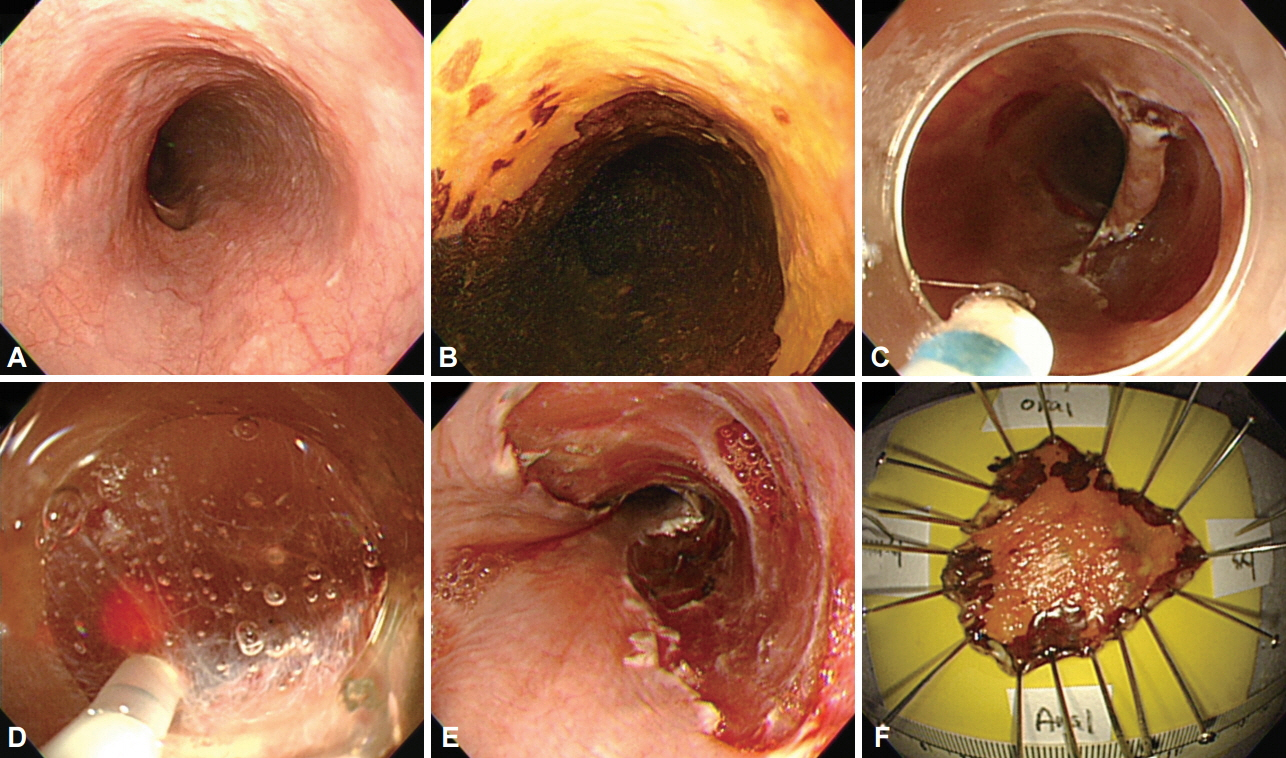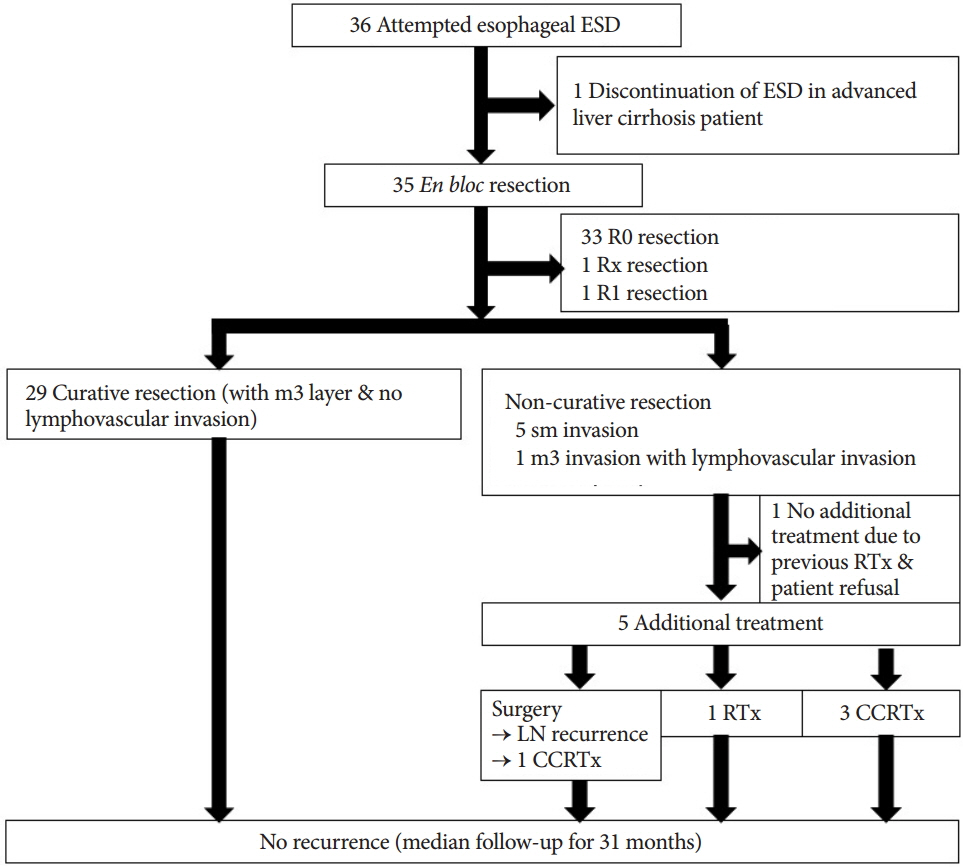Clinical Outcomes of Endoscopic Submucosal Dissection for Superficial Esophageal Squamous Neoplasms
- Affiliations
-
- 1Department of Internal Medicine, Gangnam Severance Hospital, Yonsei University College of Medicine, Seoul, Korea. dryoun@yuhs.ac
- KMID: 2165041
- DOI: http://doi.org/10.5946/ce.2015.080
Abstract
- BACKGROUND/AIMS
Endoscopic treatment has been broadly applied to superficial esophageal neoplasms. Endoscopic submucosal dissection (ESD) allows for high rates of en bloc resection, precise histological assessment, and low rates of local recurrence. The aim of this study was to evaluate the outcomes of ESD for superficial esophageal neoplasms.
METHODS
We retrospectively reviewed 36 esophageal ESDs for superficial squamous neoplasms in 32 patients between March 2009 and August 2014 at Gangnam Severance Hospital.
RESULTS
The median patient age was 64 years, and 30 men were included. The indications were early squamous cell carcinoma in 26 lesions, adenoma with high-grade dysplasia in five lesions, and low-grade dysplasia in five lesions. The en bloc resection and R0 resection rates were 97.2% (35 of 36) and 91.7% (33 of 36), respectively. Microperforation and post-ESD bleeding occurred in 5.6% (2 of 36) and 5.6% (2 of 36), respectively. Post-ESD esophageal strictures developed in five patients (13.9%). Five patients (15.6%) had an additional treatment after ESD (concurrent chemoradiation therapy in three, radiation therapy in one, and surgery in one patient). There was no disease-specific mortality during the median follow-up of 31 months.
CONCLUSIONS
Favorable clinical outcomes were observed in ESD for superficial esophageal squamous neoplasms. Esophageal ESD could be a good treatment option in terms of efficacy and safety.
Keyword
MeSH Terms
Figure
Cited by 5 articles
-
Endoscopic Treatment for Esophageal Cancer
Yang Won Min
Korean J Gastroenterol. 2018;71(3):116-123. doi: 10.4166/kjg.2018.71.3.116.A Case of Esophageal Squamous Cell Carcinoma
in situ Arising from Esophageal Squamous Papilloma
Jae Yeong Cho, Dae Young Cheung, Tae Jung Kim, Jae Kwang Kim
Clin Endosc. 2019;52(1):72-75. doi: 10.5946/ce.2018.058.Commentary on “Efficacy of Endoscopic Submucosal Dissection of Esophageal Neoplasms under General Anesthesia”
Soo In Choi, Jun Chul Park
Clin Endosc. 2019;52(3):205-206. doi: 10.5946/ce.2019.093.Long-Term Survival and Tumor Recurrence in Patients with Superficial Esophageal Cancer after Complete Non-Curative Endoscopic Resection: A Single-Center Case Series
Ji Wan Lee, Charles J. Cho, Do Hoon Kim, Ji Yong Ahn, Jeong Hoon Lee, Kee Don Choi, Ho June Song, Sook Ryun Park, Hyun Joo Lee, Yong Hee Kim, Gin Hyug Lee, Hwoon-Yong Jung, Sung-Bae Kim, Jong Hoon Kim, Seung-Il Park
Clin Endosc. 2018;51(5):470-477. doi: 10.5946/ce.2018.025.Endoscopic Submucosal Dissection for Superficial Esophageal Neoplasm: A Growing Body of Evidence
Eun Jeong Gong, Hwoon-Yong Jung
Clin Endosc. 2016;49(2):101-103. doi: 10.5946/ce.2016.045.
Reference
-
1. Sano T, Kobori O, Muto T. Lymph node metastasis from early gastric cancer: endoscopic resection of tumour. Br J Surg. 1992; 79:241–244.
Article2. Oka S, Tanaka S, Kaneko I, et al. Endoscopic submucosal dissection for residual/local recurrence of early gastric cancer after endoscopic mucosal resection. Endoscopy. 2006; 38:996–1000.
Article3. Takahashi H, Arimura Y, Masao H, et al. Endoscopic submucosal dissection is superior to conventional endoscopic resection as a curative treatment for early squamous cell carcinoma of the esophagus (with video). Gastrointest Endosc. 2010; 72:255–264.
Article4. Isomoto H, Shikuwa S, Yamaguchi N, et al. Endoscopic submucosal dissection for early gastric cancer: a large-scale feasibility study. Gut. 2009; 58:331–336.
Article5. Fujishiro M. Perspective on the practical indications of endoscopic submucosal dissection of gastrointestinal neoplasms. World J Gastroenterol. 2008; 14:4289–4295.
Article6. Kodama M, Kakegawa T. Treatment of superficial cancer of the esophagus: a summary of responses to a questionnaire on superficial cancer of the esophagus in Japan. Surgery. 1998; 123:432–439.
Article7. Araki K, Ohno S, Egashira A, Saeki H, Kawaguchi H, Sugimachi K. Pathologic features of superficial esophageal squamous cell carcinoma with lymph node and distal metastasis. Cancer. 2002; 94:570–575.
Article8. Eguchi T, Nakanishi Y, Shimoda T, et al. Histopathological criteria for additional treatment after endoscopic mucosal resection for esophageal cancer: analysis of 464 surgically resected cases. Mod Pathol. 2006; 19:475–480.
Article9. Soetikno R, Kaltenbach T, Yeh R, Gotoda T. Endoscopic mucosal resection for early cancers of the upper gastrointestinal tract. J Clin Oncol. 2005; 23:4490–4498.
Article10. Pech O, May A, Rabenstein T, Ell C. Endoscopic resection of early oesophageal cancer. Gut. 2007; 56:1625–1634.
Article11. Fujita H, Sueyoshi S, Yamana H, et al. Optimum treatment strategy for superficial esophageal cancer: endoscopic mucosal resection versus radical esophagectomy. World J Surg. 2001; 25:424–431.
Article12. Ono S, Fujishiro M, Niimi K, et al. Predictors of postoperative stricture after esophageal endoscopic submucosal dissection for superficial squamous cell neoplasms. Endoscopy. 2009; 41:661–665.
Article13. Fujishiro M, Yahagi N, Kakushima N, Kodashima S, Ichinose M, Omata M. En bloc resection of a large semicircular esophageal cancer by endoscopic submucosal dissection. Surg Laparosc Endosc Percutan Tech. 2006; 16:237–241.
Article14. Joo DC, Kim GH, Park do Y, Jhi JH, Song GA. Long-term outcome after endoscopic submucosal dissection in patients with superficial esophageal squamous cell carcinoma: a single-center study. Gut Liver. 2014; 8:612–618.
Article15. Oyama T, Tomori A, Hotta K, et al. Endoscopic submucosal dissection of early esophageal cancer. Clin Gastroenterol Hepatol. 2005; 3(7 Suppl 1):S67–S70.
Article16. Fujishiro M, Yahagi N, Kakushima N, et al. Endoscopic submucosal dissection of esophageal squamous cell neoplasms. Clin Gastroenterol Hepatol. 2006; 4:688–694.
Article17. Ishihara R, Iishi H, Uedo N, et al. Comparison of EMR and endoscopic submucosal dissection for en bloc resection of early esophageal cancers in Japan. Gastrointest Endosc. 2008; 68:1066–1072.
Article18. Higuchi K, Tanabe S, Koizumi W, et al. Expansion of the indications for endoscopic mucosal resection in patients with superficial esophageal carcinoma. Endoscopy. 2007; 39:36–40.
Article19. Kim DU, Lee JH, Min BH, et al. Risk factors of lymph node metastasis in T1 esophageal squamous cell carcinoma. J Gastroenterol Hepatol. 2008; 23:619–625.
Article20. Endo M. Endoscopic resection as local treatment of mucosal cancer of the esophagus. Endoscopy. 1993; 25:672–674.
Article21. Japanese Society for Esophageal Diseases. Guidelines for clinical and pathologic studies on carcinoma of the esophagus, ninth edition. Preface, general principles, part I. Esophagus. 2004; 1:61–88.22. Tajima Y, Nakanishi Y, Tachimori Y, et al. Significance of involvement by squamous cell carcinoma of the ducts of esophageal submucosal glands. Analysis of 201 surgically resected superficial squamous cell carcinomas. Cancer. 2000; 89:248–254.23. Repici A, Hassan C, Carlino A, et al. Endoscopic submucosal dissection in patients with early esophageal squamous cell carcinoma: results from a prospective Western series. Gastrointest Endosc. 2010; 71:715–721.
Article24. Higuchi K, Tanabe S, Azuma M, et al. A phase II study of endoscopic submucosal dissection for superficial esophageal neoplasms (KDOG 0901). Gastrointest Endosc. 2013; 78:704–710.
Article25. Mizuta H, Nishimori I, Kuratani Y, Higashidani Y, Kohsaki T, Onishi S. Predictive factors for esophageal stenosis after endoscopic submucosal dissection for superficial esophageal cancer. Dis Esophagus. 2009; 22:626–631.
Article26. Isomoto H, Yamaguchi N, Nakayama T, et al. Management of esophageal stricture after complete circular endoscopic submucosal dissection for superficial esophageal squamous cell carcinoma. BMC Gastroenterol. 2011; 11:46.
Article27. Ezoe Y, Muto M, Horimatsu T, et al. Efficacy of preventive endoscopic balloon dilation for esophageal stricture after endoscopic resection. J Clin Gastroenterol. 2011; 45:222–227.
Article28. Hashimoto S, Kobayashi M, Takeuchi M, Sato Y, Narisawa R, Aoyagi Y. The efficacy of endoscopic triamcinolone injection for the prevention of esophageal stricture after endoscopic submucosal dissection. Gastrointest Endosc. 2011; 74:1389–1393.
Article29. Saito Y, Tanaka T, Andoh A, et al. Novel biodegradable stents for benign esophageal strictures following endoscopic submucosal dissection. Dig Dis Sci. 2008; 53:330–333.
Article30. Ohki T, Yamato M, Murakami D, et al. Treatment of oesophageal ulcerations using endoscopic transplantation of tissue-engineered autologous oral mucosal epithelial cell sheets in a canine model. Gut. 2006; 55:1704–1710.
Article
- Full Text Links
- Actions
-
Cited
- CITED
-
- Close
- Share
- Similar articles
-
- Endoscopic Treatment for Esophageal Cancer
- Endoscopic Resection for the Treatment of Superficial Esophageal Neoplasms
- Endoscopic Treatment for Esophageal Cancer
- Superficial Esophageal Neoplasms Overlying Leiomyomas Removed by Endoscopic Submucosal Dissection: Case Reports and Review of the Literature
- Endoscopic Submucosal Dissection for Recurrent or Residual Superficial Esophageal Cancer after Chemoradiotherapy: Two Cases



